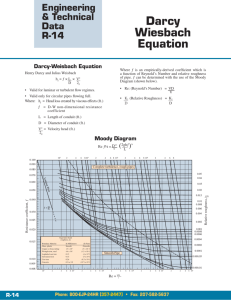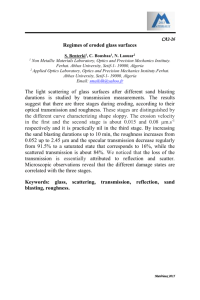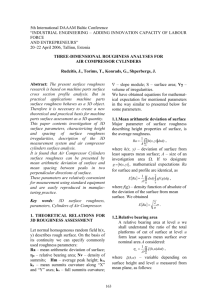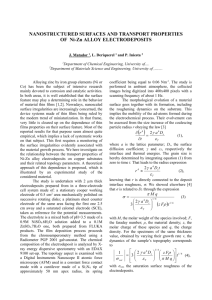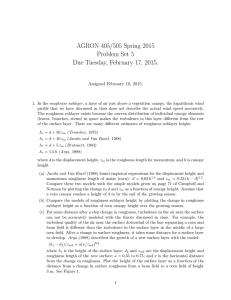Proceedings of MICROMINI 2005 3rd International Conference on Microchannels and Minichannels
advertisement
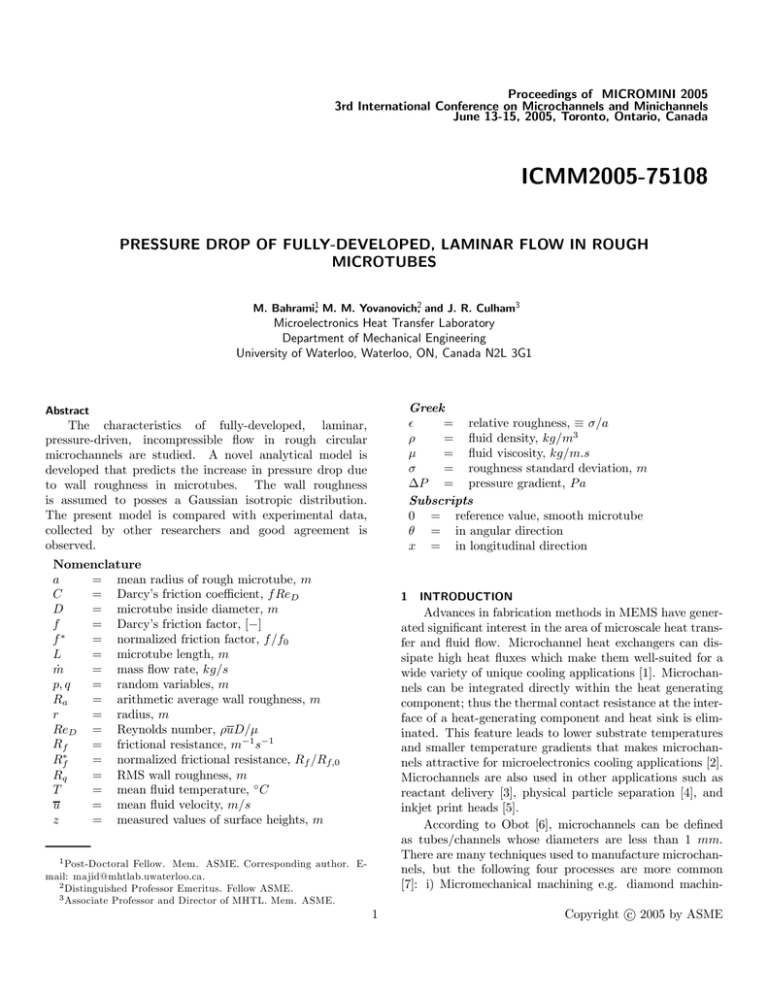
Proceedings of MICROMINI 2005
3rd International Conference on Microchannels and Minichannels
June 13-15, 2005, Toronto, Ontario, Canada
ICMM2005-75108
PRESSURE DROP OF FULLY-DEVELOPED, LAMINAR FLOW IN ROUGH
MICROTUBES
M. Bahrami1, M. M. Yovanovich2, and J. R. Culham3
Microelectronics Heat Transfer Laboratory
Department of Mechanical Engineering
University of Waterloo, Waterloo, ON, Canada N2L 3G1
Greek
²
= relative roughness, ≡ σ/a
ρ
= fluid density, kg/m3
µ
= fluid viscosity, kg/m.s
σ
= roughness standard deviation, m
∆P = pressure gradient, P a
Subscripts
0 = reference value, smooth microtube
θ = in angular direction
x = in longitudinal direction
Abstract
The characteristics of fully-developed, laminar,
pressure-driven, incompressible flow in rough circular
microchannels are studied. A novel analytical model is
developed that predicts the increase in pressure drop due
to wall roughness in microtubes. The wall roughness
is assumed to posses a Gaussian isotropic distribution.
The present model is compared with experimental data,
collected by other researchers and good agreement is
observed.
Nomenclature
a
= mean radius of rough microtube, m
C
= Darcy’s friction coefficient, f ReD
D
= microtube inside diameter, m
f
= Darcy’s friction factor, [−]
f∗
= normalized friction factor, f /f0
L
= microtube length, m
ṁ
= mass flow rate, kg/s
p, q
= random variables, m
Ra
= arithmetic average wall roughness, m
r
= radius, m
ReD = Reynolds number, ρuD/µ
Rf
= frictional resistance, m−1 s−1
∗
Rf
= normalized frictional resistance, Rf /Rf,0
Rq
= RMS wall roughness, m
T
= mean fluid temperature, ◦ C
u
= mean fluid velocity, m/s
z
= measured values of surface heights, m
1
INTRODUCTION
Advances in fabrication methods in MEMS have generated significant interest in the area of microscale heat transfer and fluid flow. Microchannel heat exchangers can dissipate high heat fluxes which make them well-suited for a
wide variety of unique cooling applications [1]. Microchannels can be integrated directly within the heat generating
component; thus the thermal contact resistance at the interface of a heat-generating component and heat sink is eliminated. This feature leads to lower substrate temperatures
and smaller temperature gradients that makes microchannels attractive for microelectronics cooling applications [2].
Microchannels are also used in other applications such as
reactant delivery [3], physical particle separation [4], and
inkjet print heads [5].
According to Obot [6], microchannels can be defined
as tubes/channels whose diameters are less than 1 mm.
There are many techniques used to manufacture microchannels, but the following four processes are more common
[7]: i) Micromechanical machining e.g. diamond machin-
1 Post-Doctoral Fellow. Mem. ASME. Corresponding author. Email: majid@mhtlab.uwaterloo.ca.
2 Distinguished Professor Emeritus. Fellow ASME.
3 Associate Professor and Director of MHTL. Mem. ASME.
1
c 2005 by ASME
Copyright °
is a need for a better understanding of the effect of wall
roughness on fluid characteristics in microtubes. No physical model exists in the literature that accounts for the wall
roughness effects. This paper is the first attempt to develop
a model to predict the pressure drop of the fully-developed
laminar liquid flows in rough microtubes.
2
FRICTIONAL RESISTANCE
The flow regime through microtubes depends strongly
on the method used to induce the motion of the fluid. The
flow can be obtained in two ways: i) apply an external
pressure gradient, i.e. pressure driven motion. In this case
a Hagen-Poiseuille flow profile is generated along the channel. The Reynolds number associated with the flow is in
general small, due to the small radii, the flow is usually laminar and the velocity varies across the entire cross-sectional
area of the channel. ii) Apply an external electric field, i.e.
electrokinetically driven flow. In this case the fluid velocity
only varies within the so-called Debye screening layer near
the channel walls. It is experimentally demonstrated that,
in this case, the profile is practically uniform (slug flow)
across the entire cross-section [15]. The focus of this study
is on the pressure driven flow only.
In laminar flow at a sufficiently large distance from the
entrance, the velocity distribution across the cross-section
becomes independent of the coordinate along the direction
of flow. The fluid moves under the influence of the pressure
gradient which acts in the direction of the axis. Owing to
friction, individual layers act on each other with shearing
stress which is proportional to the velocity gradient in the
axis normal to the direction of flow. Hence, a fluid flow
particle is accelerated by the pressure gradient and retarded
by the frictional shearing stress, i.e. no inertia forces exist.
This flow is called Hagen-Poisuille.
Applying a force balance and the no-slip boundary condition, one can find a relationship between the mass flow
rate ṁ and the pressure gradient ∆P for a smooth circular
tube of radius, a, as follows:
Figure 1. CROSS-SECTION OF A ROUGH MICROTUBE, FROM REF. [20]
ing, laser processes, microdrilling; ii) X-ray machining
(such as LIGA LItographie-Galvanoforming-Abformung,
iii) Photolithographic-based such as Si chemical etching,
and iv) surface and surface-proximity-micromachining.
Many researchers have conducted experiments and reported friction factors higher than values predicted by conventional theory (smooth pipes) for liquids in microchannels
during the last 15 years; see survey articles [2; 7; 8; 9]. Tuckerman [10] was the first to experimentally investigate the
liquid flow and heat transfer in microchannels. He reported
that the flow approximately followed the Hagen-Poiseuille
theory. Pfahler et al. [11] and [12] conducted experimental
studies on the fluid flow in microchannels. They observed
that in the relatively large channels the experimental observations were in general agreement with the predictions
from conventional equations. However, in the smallest of
the channels, they observed a significant deviation from the
classical predictions. Mala and Li [13] measured the friction
factor of water in microtubes with diameters ranging from
50 to 254 µm. They also reported good agreements with the
classical theory in large diameters microtubes. They proposed a roughness-viscosity model to explain the increase in
the friction factor of the microchannels. The model of [13],
however, did not encompass the physical mechanism and
the effect of wall roughness. Li et al. [14] experimentally
studied the frictional resistance for deionized water flow in
microtubes. They reported a 15%-37% higher friction factor than the classical theory for rough microtubes. They
concluded that the effect of wall roughness cannot be neglected for microtubes. However, they did not propose any
model to explain the higher friction factors.
As the diameter of (micro-) tubes decreases the surface
to volume ratio, which is equal to 2/r, increases rapidly.
As a result, the surface phenomena- including the effect of
wall roughness, see Fig. 1, become more significant. There
ṁ =
πa4 ρ∆P
8 µL
(1)
where L, ρ, and µ are the length of the pipe (L À a),
density, and viscosity of the fluid, respectively. Equation
(1) states that the mass flow rate of the fluid is proportional
to the pressure drop per unit length (∆P/L) and the fourth
power of the pipe radius a. The mean velocity of the fluid
is, u = ṁ/πρa2 ; thus the relation between the pressure
gradient and the mean velocity is
∆P
8µ u
= 2
L
a
2
(2)
c 2005 by ASME
Copyright °
According to Darcy’s formula, the friction factor, f, is defined by
∆P 4a
(3)
f=
L ρ u2
taken within a sampling length from the graphical centerline
[17]. The value of Ra is
Z
1 l
Ra =
|z (x)| dx
(7)
l 0
It can easily be shown that f = 64/Re D , where Re D is the
Reynolds number of a tube with a diameter D = 2a.
With the electrical network analogy in mind, we introduce a frictional resistance as:
ṁ =
∆P
Rf,0
where l is the sampling length in the x direction and z is
the measured value of the surface heights along this length.
When the surface is Gaussian, the standard deviation σ is
identical to the RMS value [18], Rq .
s
Z
1 l 2
σ = Rq =
z (x) dx
(8)
l 0
(4)
where Rf,0 is the frictional resistance of a smooth microtube
of radius a and length L. Combining Eqs. (1) and (4), one
finds
8µ L
Rf,0 =
(5)
πρ a4
For a Gaussian surface, Ling [19] showed that the average
and RMS values are related as follows:
r
π
(9)
Rq ≈
Ra ≈ 1.25Ra
2
Note that the frictional resistance is not linearly proportional to the radius.
The relationship between the frictional resistance, defined in this study, and the Darcy’s friction factor f is
f=
4π a3
Rf,0
uL
4
The assumptions of the present model can be summarized as:
(6)
• the fully-developed laminar flow is modeled. The fluid
is forced to move by a pressure gradient applied to the
ends of the microtubes, i.e. pressure-driven flow.
• the fluid is Newtonian and the microtube cross-section
is circular.
• the microtube walls are rough; the roughness is assumed
to be Gaussian, i.e., isotropic in all directions. Also,
there are no macro deviations or waviness inside the
microtubes.
• rarefaction, compressibility, and slip-on-walls effects are
negligible.
• fluid properties are constant.
The concept of frictional resistance, introduced in Eq. (4),
may also be used to construct frictional resistance networks
to analyze more complex systems.
3
FRICTIONAL RESISTANCE OF ROUGH MICROTUBES
WALL ROUGHNESS
Roughness or surface texture can be thought of as the
surface deviation from the nominal topography. The term
Gaussian is used to describe a surface where its asperities
are isotropic and randomly distributed over the surface. It
is not easy to produce a wholly isotropic roughness.
According to Liu et al. [16] five types of instruments are
currently available for measuring the surface topography:
i) stylus-type surface profilometer, ii) optical (white-light
interference) measurements, iii) Scanning Electron Microscope (SEM), iv) Atomic Force Microscope (AFM), and v)
Scanning Tunneling Microscope (STM). Among these, the
first two instruments are usually used for macro-to-macro
asperity measurements, whereas the others may be used for
micro or nanometric measurements. Surface texture is most
commonly measured by a profilometer, which draws a stylus
over a sample length of the surface. A datum or centerline
is established by finding the straight line, or circular arc in
the case of round components, from which the mean square
deviation is a minimum. The arithmetic average of the absolute values of the measured profile height deviations, Ra ,
Some researchers have reported that the transition from
laminar to turbulent flow regimes starts at lower Reynolds
numbers in microchannels. However, this early transition
has not been observed by Judy et al. [20]. Also Obot [6]
presented a critical review of published data and concluded
that there is hardly any evidence to support the occurrence of transition of turbulence in smooth microchannels
for Re < 1000. Therefore, the focus of this study is on the
laminar flow regime and the transition will not be discussed.
Consider a long rough microtube with the mean radius
of, a, and length L À a, Fig. 2. As shown schematically in
the figure, the wall roughness of the microtube is assumed
to posses a Gaussian distribution in the angular direction.
Owing to the random nature of the wall roughness, an exact
value of the local radius, r, can not be used for rough microtubes. Instead, probabilities of occurring different radii
3
c 2005 by ASME
Copyright °
a
P1
r
a
a
P
x
q
dp
r = r(p,q)
q
dx
p
dq
φ(p)
mean q
radius
mean
radius
Figure 2. CROSS-SECTION OF A MICROTUBE: WALL ROUGHNESS
AND GAUSSIAN DISTRIBUTION
φ (q)
Figure 3. LONGITUDINAL CROSS-SECTION OF RANDOM ROUGH MICROTUBE
should be computed. A random variable, p, is used to represent the deviations of the local radius, r, in the angular
direction, Fig. 2. The standard deviation of p is the wall
roughness σ θ and has the following Gaussian distribution:
µ
¶
p2
1
exp −
(10)
φ (p) = √
2 σ 2θ
2πσθ
superposition of the two random variables, as shown in Eq.
(12). Note that the variables p and q are independent. For
argument sake, consider an imaginary case where a microtube has roughness only in the angular direction; thus one
can write, r = r(p). As a result, an average of these variables [r = a + (p + q)/2] is not correct.
In the general case, the standard deviations σθ and σ x
might be different; however in this study, we assume an
isotropic roughness, i.e. σθ = σ x = σ.
The frictional resistance dRf for an infinitesimal element dx can be written using Eq. (5) as:
Z
Z
8µ dx +∞ +∞ φ (p) φ (q)
dRf =
dp dq
(13)
πρ
r4
−∞
−∞
The local radius can vary over a wide range of values from
much larger to much smaller radii than the mean radius a,
valleys and hills in the figure, with the Gaussian probability
distribution shown in Eq. (10). The microtube wall also has
roughness in the longitudinal direction x, see Fig. 3. The
variations of the local radius of the microtube, r, in the
longitudinal direction is shown by another random variable
q, with the same Gaussian distribution as in the angular
direction.
µ
¶
1
q2
φ (q) = √
exp −
(11)
2 σ 2x
2πσ x
Equation (13) considers the probabilities of all values of radius, r, occurring according to the Gaussian distribution.
It also takes into account their effects on the frictional resistance dRf . It should be noted that it is mathematically
possible for the variables p and q to have values ranging
from −∞ to +∞, see Eqs. (10) and (11). However, the
probability of occurring much larger/ smaller radii than the
mean radius, a, are quite small, see Fig. 6.
The total frictional resistance over the length, L, is
Z L Z +∞ Z +∞
4µ
φ (p) φ (q)
Rf = 2 2
dp dq dx (14)
π ρσ 0 −∞ −∞ (a + p + q)4
The local radius of the microtube can be written as
r =a+p+q
L >> a
(12)
where a is the mean statistical value of the local radius,
r, over the cross-sections over the entire length, L, of the
microtube.
To better understand Eq. (12), consider cross-sections
of a rough microtube at different longitudinal locations, Fig.
3. These cross-sections have different mean radii where the
probability of these radii occurring can be determined from
Eq. (11), a + q. Meanwhile, the actual radius at each crosssection varies around the mean radius, a + q, in the angular
direction (variations of p) with the probability distribution
described in Eq. (10). Therefore, the local radius of a microtube, r, is a function of both random variables p and
q, i.e. r = r(p, q). We assume that the local radius is the
Equation (14) calculates an effective frictional resistance for
rough microtubes. Integrating over the length L, one finds
(
)
Z +∞ Z +∞
φ (p) φ (q)
1
8µL
Rf =
dp dq
πρa4 2πσ 2 −∞ −∞ (1 + p/a + q/a)4
| {z }|
{z
}
Rf,0
effect of wall roughness on frictional resistance
(15)
4
c 2005 by ASME
Copyright °
Table 1. EFFECT OF WALL ROUGHNESS ON FRICTIONAL RESISTANCE
101
R*f = R f / R f 0
∞
100
10-1 -3
10
smooth microtubes
(σ = 0)
-2
10
ε=σ/a
10
relative roughness
normalized frictional
² = σ/a
resistance Rf∗
0.01
1.002
0.03
1.021
0.05
1.053
0.07
1.130
0.08
1.170
0.10
1.300
0.12
1.450
-1
Figure 4. EFFECT OF WALL ROUGHNESS ON FRICTIONAL RESISTANCE
The accuracy of the above correlation is within a few percent of the numerical solution, less than 3%. Note that
in the limit where roughness goes to zero, the effective frictional resistance predicted by the present model approaches
the Hagen-Poisuille theory.
Figure 4 illustrates the trend of the normalized frictional resistance Rf∗ as relative roughness ² is varied. Some
values of Rf∗ are listed in Table 1 to better demonstrate the
effect of roughness on the pressure drop.
From Eq. (6), it can be shown that the effect of wall
roughness on the friction factor f is the same as the frictional resistance, i.e.
where Rf,0 is the frictional resistance of the smooth microtube, where no roughness exists, see Eq. (5). Thus, the
effect of wall roughness on the frictional resistance can be
presented as a normalized frictional resistance or a correction factor, i.e. Rf∗ = Rf /Rf 0 . After changing variables and
simplifying, one finds
¡
¢
¡
¢
Z +∞ Z +∞
exp −u2 /2 exp −v2 /2
1
Rf∗ =
du dv
2π −∞ −∞
[1 + ² (u + v)]4
(16)
where ² is the relative wall roughness
²=
σ
a
f∗ =
(17)
Note that in this study, the relative roughness, ², is defined
as the RMS wall roughness over the radius of the microtube.
Whereas the conventional relative roughness is defined as
roughness over diameter.
The integral in Eq. (16) can not be solved analytically; thus it must be solved numerically over a range of
4
relative roughness. It can be shown that [1 + ² (u + v)] u
4
4
(1 + ²u) (1 + ²v) where ² ¿ 1; thus Eq. (16) can be simplified to
(Z
¡
¢ )2
+∞
exp −u2 /2
1
∗
(18)
du
²¿1
Rf =
2π
[1 + ²u]4
−∞
The numerical solution to Eq. (16) is curve-fitted and the
following correlations can be used to calculate Rf∗
⎧
1
⎪
² ≤ 0.1
⎨
1 − 23 ²2
∗
Rf =
(19)
⎪
1
⎩
0.1
<
²
<
0.15
1 − 50 ²2.4
f
= Rf∗
f0
(20)
Equations (20) and (19) can be employed to calculate the
Darcy’s friction factor for rough microtubes.
As shown in Fig. 4 and Table 1, the effect of roughness
is negligible for relative roughness values ² < 0.03. However, as relative roughness increases the correction factor
Rf∗ increases rapidly, e.g. for a microtube with a relative
roughness of 0.08, an increase of ≈17% in frictional resistance is predicted by the present model. As ² increases
to approximately ≈0.2, the normalized frictional resistance
approaches infinity.
It should be noted that the relative roughness of 0.2 is
extremely high, imagine a microtube where its wall roughness (standard deviation) is 1/5 of its radius. It is also worth
noting that in the Gaussian distribution as the standard
deviation increases, the probability of occurring radii with
larger deviations from the mean radius becomes higher, see
Fig. 6. In other words, in rougher microtubes-higher values
of σ- the probability of occurring smaller radii is higher,
which leads to higher pressure drops.
5
c 2005 by ASME
Copyright °
1
7
Rf ∝ 1 / a4
Rf, a0 − Rf, a0 + da < Rf, a0 − da − Rf, a0
σ1 = 0.5
σ2 = 2.0
0.8
mean
value
5
Rf, a0 − da
4
σ1
0.6
φ (x)
∝ frictional resistance, Rf
6
3
σ1 < σ2
0.4
Rf, a0
2
Rf, a0 + da
0.2
1
σ2
da
0
a0
0.1
radius
0.2
0.3
0
-5
0
5
x
Figure 5. RELATIONSHIP BETWEEN FRICTIONAL RESISTANCE AND
RADIUS OF ROUGH MICROTUBES
Figure 6. GAUSSIAN DISTRIBUTION
As seen in Fig. 4, increasing roughness, while all other
parameters are kept constant, results in an increase in the
frictional resistance or equivalently the pressure drop, see
Eq. (20). We know that by assuming the Gaussian distribution, the probabilities of having smaller and/or larger
radii microtubes (than the mean radius a) are identical;
also the mean statistical radius of the microtube remains
unchanged as the roughness is increased. Then the question may arise: why the frictional resistance increases as
roughness increases? The answer to this question lies in the
relationship between the frictional resistance and the radius
of microtube, Eq. (5). The frictional resistance is inversely
proportional to the radius to the fourth power, Rf ∝ 1/a4 .
Figure 5 illustrates the frictional resistance as a function of
the radius. The frictional resistance of a slightly smaller radius (a0 −da) is much larger than the resistance of a slightly
larger radius (a0 + da), see Fig. 5. Therefore, the resistance
of smaller radii microtubes controls the effective frictional
resistance, and that is why the frictional resistance increases
as a microtube becomes rougher.
5
1.8
averaged range
1.6
1.4
1.2
R*f
1
Li et al. [14] data
stainless steel microtube
wall roughness ≈ 6 µm
microtube diameter, D = 128 µm
fluid: deionized water
microtube length, L = 39.30 mm
0.8
0.6
0.4
0.2
0
0
500
1000
1500
2000
ReD
Figure 7. COMPARISON OF PRESENT MODEL TO LI ET AL. [14] DATA,
D = 128 µm
uncertainty of the experimental data were reported by different researchers all in the vicinity of 10%; thus, a constant
error bound of 10% is considered for all data.
Li et al. [14] used glass, silicon and stainless steel microtubes with diameters ranging from 79.9 to 166.3 µm,
from 100.25 to 205.3 µm, and from 128.76 to 179.8 µm,
respectively. To determine the wall conditions, the three
types of microtubes were milled open along the axial direction. The wall roughness was measured using a Talysurf-120
profilometer. The wall roughness of glass and silicon microtubes were reported in order of 0.05 µm; thus the glass and
the silicon microtubes can be considered as smooth microtubes. However, the stainless steel microtubes exhibited a
relatively large wall roughness. They [14] did not report the
exact value of Rq or Ra for wall roughness; only a “peak-
COMPARISON WITH DATA
In this section, the present model is compared
to published data where the wall roughness was reported/measured.
Table 2 summarizes the experimental data that have
been used in the comparison. A constant roughness value is
used for the same microtube material for all radii reported
in each reference. In other words, the roughness is assumed
not to be a function of the microtube radius. This assumption may not be strictly correct, unfortunately none of the
available experimental studies reported the wall roughness
for different radii of microtubes. Different values for the
6
c 2005 by ASME
Copyright °
Table 2. SUMMARY OF EXPERIMENTAL DATA USED IN COMPARISON
Code
Reference
D
σ≈
(µm)
(µm)
Notes
microtube: AISI316 stainless steel, liquid: R-114
CCGZ
Celata et al. [21]
130
4.31
100 < ReD < 8000
a statistical method used to measure Ra
microtube: silicon, liquid: deionized water
JZHL
Jiang et al. [22]
8 − 42
0.3
0.12 < ReD < 3
microscopic image snaps used to measure roughness
microtube: stainless steel, liquid: water
KSS
Kandlikar et al. [23]
1076
2.4 − 3.73
500 < ReD < 2500
Alpha-Step 200 profilometer used to measure Ra
microtube: stainless steel, liquid: deionized water
LDG
Li et al. [14]
128 − 179
6
500 < ReD < 2500
a Talysurf-120 profilometer used to measure roughness
ML
Mala and Li [13]
SST: 63 − 254
2.5
FST: 50 − 250
2.0
microtube: stainless steel (SST), fused silica (FST)
100 < ReD < 2500, liquid: deionized water
manufacturer info reported for roughness, no measurements
1.8
valley roughness” in the order of ≈ 5.5 µm was reported
for stainless steel microtubes. Through experiments, Li et
al. showed that for glass and silicon microtubes the conventional theory in the laminar regime holds. For stainless
steel microtubes the friction factors were higher than the
prediction of the classical theory. Figures 7 to 9 show the
comparison between the present model, Eq. (19), and some
of the [14] data sets. As can be seen, the model shows good
agreement with these data.
averaged range
1.6
1.4
1.2
R*f
1
L = 39 µm (T=19 C)
L = 39.3 µm (T = 26 C)
L = 58.14 µm (T = 26 C)
model
0.8
0.6
Li et al. [14] data
stainless steel microtube
wall roughness ≈ 6 µm
microtube diameter, D = 128.7 µm
fluid: deionized water
0.4
Mala and Li [13] studied experimentally the flow of
deionized water through circular microtubes of fused silica
and stainless steel with diameters ranging between 50 to
254 µm. They reported a strange non-linear trend between
pressure drop and flow rate for low Reynolds numbers, and
that the friction factors were consistently higher than the
conventional values. Figures 10 and 11 represents the comparison between the model and two sets of the [13] data.
0.2
0
0
500
1000
1500
2000
ReD
Figure 8. COMPARISON OF PRESENT MODEL TO LI ET AL. [14], D =
128 µm, T = 19, 26◦ C
Jiang et al. [22] studied the trend of water flow through
glass microtubes. Their circular microtubes were fabricated
by the glass drawn process, with wall roughness in the order of 0.3 µm. The microtubes diameters ranged from 8
to 42 µm. The range of the Reynolds number, in which
their experiments were conducted, was very low, see Table 2. However, they did not report any trends similar to
those of Mala and Li [13]. Figure 12 shows the comparison
7
c 2005 by ASME
Copyright °
1.8
1.8
averaged range
1.6
averaged range
1.6
1.4
1.2
1.2
1
1
*
R*f
Rf
1.4
0.8
Li et al. [14] data
stainless steel microtube
wall roughness ≈ 6 µm
microtube diameter, D = 179.8 µm
fluid: deionized water
microtube length, L = 84.26 mm
0.6
0.4
0.2
0
0
500
1000
present model
0.8
0.6
Mala and Li [13] data
fused silica microtube (FST)
wall roughness ≈ 2 µm
microtube diameter, D = 50 µm
fluid: deionized water
0.4
0.2
1500
0
2000
0
500
1500
2000
Figure 11. COMPARISON OF PRESENT MODEL TO MALA AND LI. [13],
FUSED SILICA, D = 50 µm
Figure 9. COMPARISON OF PRESENT MODEL TO LI ET AL. [14], D =
179 µm
1.8
1.8
averaged range
1.6
1.6
1.4
1.4
1.2
1.2
1
R*f
R*f
0.8
0.6
0.6
Mala and Li [13] data
stainless steel microtube (SST)
wall roughness ≈ 2.5 µm
microtube diameter, D = 63.5 µm
fluid: deionized water
0.4
0.2
0
500
1000
averaged range
1
present model
0.8
0
1000
ReD
ReD
present model
Jiang et al. [22] data
glass microtube
wall roughness ≈ 0.3 µm
microtube diameter, D = 17 µm
fluid: deionized water
0.4
0.2
1500
0
2000
0
0.25
0.5
0.75
1
ReD
ReD
Figure 10. COMPARISON OF PRESENT MODEL TO MALA AND LI. [13],
STAINLESS STEEL, D = 63.5 µm
Figure 12. COMPARISON OF PRESENT MODEL TO JIANG ET AL. [22],
GLASS, D = 17 µm
between the present model and a set of the [22] data.
Celata et al. [21] performed an experimental analysis
of the friction factor in stainless steel capillary tubes with
a diameter of 130 µm with R114 as the fluid, see Table 2.
Their reported values of Ra have been converted to σ = Rq ,
using Eq. (9), to be used in the comparison.
Kandlikar et al. [23] investigated experimentally the
role of the wall roughness on the pressure drop in two microtubes with different diameters 1067 and 620 µm. The
wall roughness of microtube walls was changed by etching
with an acid solution. A micrograph scan of the microtubes
was used to measure the average roughness, Ra , see Eq. (7).
Their reported values of Ra have been converted to σ = Rq ,
using Eq. (9), to be used in the comparison.
The frictional resistance constant, C = f ReD , is not
a function of Reynolds number and remains unchanged for
the laminar regime. Therefore, the experimental data are
averaged over the laminar region; the transitional data are
not included in the comparison. For each data set, the relative roughness is calculated using ² = σ/a. As a result, for
each experiment data set, a relative roughness and a normalized frictional resistance can be obtained, dashed lines
in Figs. 7 to 12 demarcate the averaged ranges. Figure
13 shows the experimental normalized frictional resistance
as a function of their relative roughness; for assigned codes
to experimental data sets see Table 2. As previously men8
c 2005 by ASME
Copyright °
1.5
♣
♥
♦
1.25
R*f
∪∅
◊
♠
1
0.75
⊗⊕
x
x
⊕
⊗
∅
∪
◊
♣
♦
♥
♠
R*f = R f / R f,0 = f / f 0
0.5 -3
10
10
-2
ε=σ/a
10
CCGZ T=17
CCGZ T=33
JZHL d=8
JZHL d=14
JZHL d=17
JZHL d=24
JZHL d=42
ML, FST d=50
ML, SST d=63.5
ML, SST d=101.6
ML, SST d=130
ML, SST d=152
ML, FST d=150
ML, SST d=254
LDG, d=179
LDG, d=136
LDG, d=128
LDG, d=128, T = 19
KSS, d=1076, σ = 2.4
KSS, d=1076, σ = 1.9
KSS, d=1076, σ = 2.9
model
-1
Figure 13. EFFECT OF RELATIVE ROUGHNESS ON PRESSURE DROP OF MICROTUBES: COMPARISON OF PRESENT MODEL WITH ALL DATA
variables. In the present model, the local radius is assumed
to be the superposition of the two random variables. The
effect of wall roughness on the frictional resistance is presented as a normalized frictional resistance or a correction
factor; the final results are reported in the form of a compact correlation. It is found that the effect of roughness is
to increase the pressure drop in microtubes. The effect of
roughness can be neglected when relative roughness is less
than 3%. It is observed that the constant in the conventional frictional resistance, C = f ReD , is a function of relative roughness, i.e. C = C(²). The published experimental
data, in which the roughness is reported, are collected and
compared with the present model. The present model exhibits the influence of roughness and predicts the pressure
drop within the uncertainty of data.
tioned, the non-linear trend of Mala and Li [13] data (at
low Re numbers) has not been observed by any other researchers. Therefore, those data points are not included in
the averaged values shown in Fig. 13. The agreement between the model and the data is relatively good; within the
10% for most of data points. More importantly, the present
model shows the trends of the data as relative roughness
increases.
6
SUMMARY AND CONCLUSIONS
The influence of wall roughness on the laminar, fully
developed liquid flow in microtubes is studied and a new
model is proposed. The concept of frictional resistance is
introduced and its relation to the Darcy’s friction coefficient
is derived.
The present model assumes an isotropic Gaussian distribution for wall roughness. Also, the rarefaction, compressibility, and slip-on-wall effects are assumed to be negligible. Owing to the random nature of the wall roughness, an
exact value of the local radius can not be used for rough microtubes. Instead, probabilities of occurring different radii
should be computed. Two independent random variables
are considered to account for the deviations of the local radius in the angular and longitudinal directions. The local
radius of a microtube is a function of these two random
There is a need for carefully designed experimentation
aimed at more comprehensive wall roughness and pressure
drop measurements. For most conventional microtubes, the
relative roughness is small, in the order of few percent. According to the model, the increase in the pressure drop for
these microtubes are within the uncertainty of the current
experimental arrangements, i.e. 10%. This makes the validation of the present model for relatively smooth microtube
a difficult task.
9
c 2005 by ASME
Copyright °
ACKNOWLEDGMENT
The authors gratefully acknowledge the financial support of the Centre for Microelectronics Assembly and Packaging, CMAP and the Natural Sciences and Engineering
Research Council of Canada, NSERC. Our thanks go to
Mr. K. Narimani for his helpful comments on Section 4.
[13]
[14]
REFERENCES
[15]
[1] D. B. Tuckerman and R. F. Pease, “High-performance
heat sinking for vlsi,” IEEE Electronic Device Letters,
no. 5, pp. 126—129, 1981.
[2] C. B. Sobhan and S. V. Garimella, “A comparative
analysis of studies on heat transfer and fluid flow in
microchannels,” Microscale Thermophysical Engineering, vol. 5, no. 4, pp. 293—311, 2001.
[3] A. V. D. Berg, W. Olthius, and P. Bergveld, Micro
Total Analysis Systems. Boston, MA, U.S.A: Kluwer
Academic Press, 2000.
[4] R. Reston and E. Kolesar, “Silicon-miromachined gas
chromatography system used to separate and detect
ammonia and nitrogen dioxide,” Journal of Microelectromechanical Systems, vol. 65, pp. 2637—2642,
1994.
[5] R. Allen, J. Meyer, and W. Knight, “Thermodynamics and hydrodynamics of thermal ink jets,” HewlettPackard Journal, vol. 36, no. 5, pp. 21—27, 1985.
[6] N. T. Obot, “Toward a better understanding of friction and heat/mass transfer in microchannels- a literature review,” Microscale Thermophysical Engineering,
vol. 6, pp. 155—173, 2002.
[7] G. L. Morini, “Single-phase convective heat transfer
in microchannels: A review of experimental results,”
International Journal of Thermal Sciences, vol. 43,
pp. 631—651, 2004.
[8] A. B. Duncan and G. P. Peterson, “Review of microscale heat transfer,” Journal of Applied Mechanics
Review, vol. 47, pp. 397—428, 1994.
[9] I. Papautsky and T. Ameel, “A review of laminar
single-phase flow in microchannels,” ASME, Proceedings of Int. Mech. Eng Congress Expos Proc (IMECE)
2001, ASME, New York, vol. 2, pp. 3067—3075, 2001.
[10] D. B. Tuckerman, Heat Transfer Microstructures for
Integrated Circuits. PhD thesis, Stanford University,
Dept. of Electrical Eng., California, USA, 1984.
[11] J. Pfahler, J. Harley, H. H. Bau, and J. Zemel, “Liquid
and gas transport in small channels,” ASME Dynamic
Systems and Control Division (Publication) DSC, Microstructures, Sensors, and Actuators, vol. 19, pp. 149—
157, 1990.
[12] J. Pfahler, J. Harley, and H. H. Zemel, “Gas and liquid
flow in small channels,” ASME Dynamic Systems and
[16]
[17]
[18]
[19]
[20]
[21]
[22]
[23]
10
Control Division (Publication) DSC, Microstructures,
Sensors, and Actuators, vol. 32, pp. 49—60, 1991.
G. M. Mala and D. Q. Li, “Flow characteristics of water in microtubes,” International Journal of Heat Fluid
Flow, vol. 20, no. 2, pp. 142—148, 1999.
Z. Li, D. Du, and Z. Guo, “Experimental study on
flow characteristics of liquid in circular microtubes,”
Microscale Thermophysical Engineering, vol. 7, no. 3,
pp. 253—265, 2003.
G. M. Whitesides and A. D. Stroock, “Flexible methods for microfluidics,” Physics Today, vol. 6, pp. 42—48,
2001.
G. Liu, Q. Wang, and C. Ling, “A survey of current
models for simulating contact between rough surfaces,”
Tribology Trans., vol. 42, no. 3, pp. 581—591, 1999.
“Ansi b46.1: Surface texture: Surface roughness, waviness and lay,” 1985.
K. L. Johnson, Contact Mechanics, ch. 13. Cambridge,
UK: Cambridge University Press, 1985.
F. F. Ling, “On asperity distributions of metalic surfaces,” Journal of Applied Physics, vol. 29, no. 8, 1958.
J. Judy, D. Maynes, and B. W. Webb, “Characterization of frictional pressure drop for liquid flows
through microchannels,” International Journal of Heat
and Mass Transfer, vol. 45, pp. 3477—3489, 2002.
G. Celata, M. Cumo, M. Guglielmi, and G. Zummo,
“Experimental investigation of hydraulic and single
phase heat transfer in 0.130 mm capillary tube,” Eng.
6, Microscale Thermophys, pp. 85—97, 2002.
X. N. Jiang, X. Y. Huang, and C. Y. Liu, “Laminar flow
through microchannels used for microscale cooling systems,” IEEE CPMT Electronic Packaging Technology
Conference, pp. 119—122, 1997.
S. G. Kandlikar, S. Joshi, and S. Tian, “Effect of channel roughness on heat transfer and fluid flow characteristics at low reynolds numbers in small diameter
tubes,” Proceedings of the National Heat Transfer Conference, ASME, vol. 2, pp. 1609—1618, 2001.
c 2005 by ASME
Copyright °


